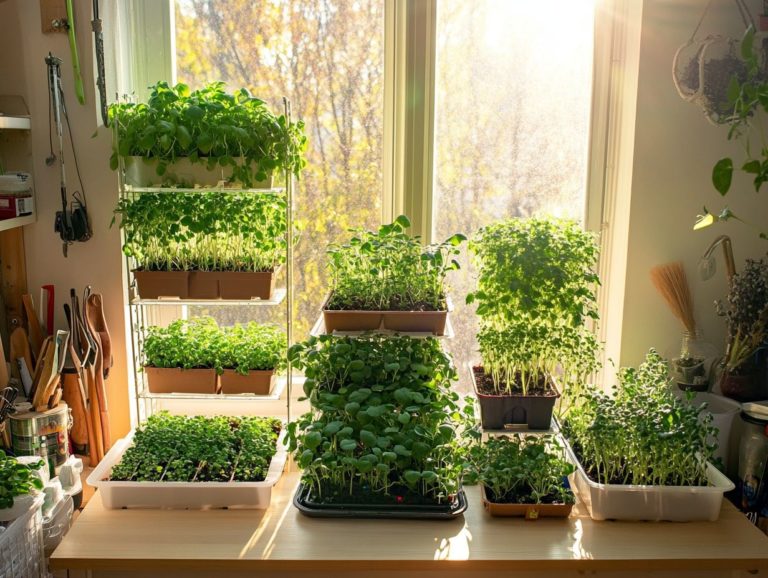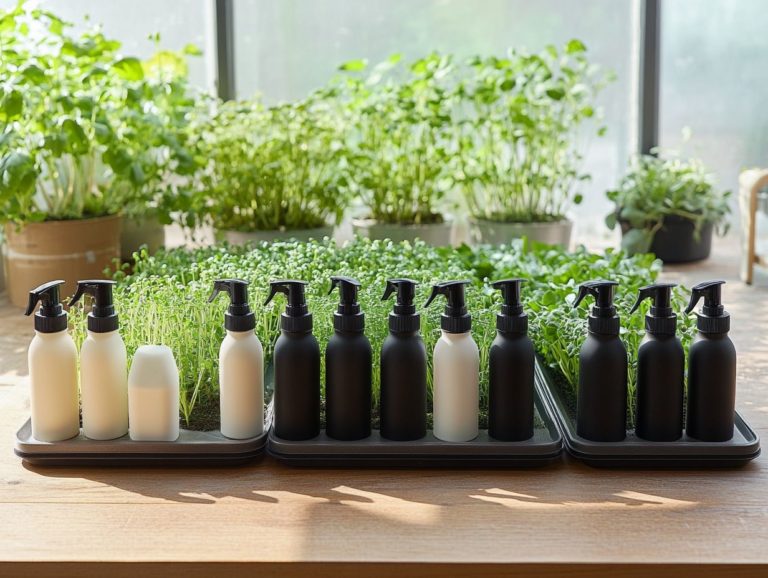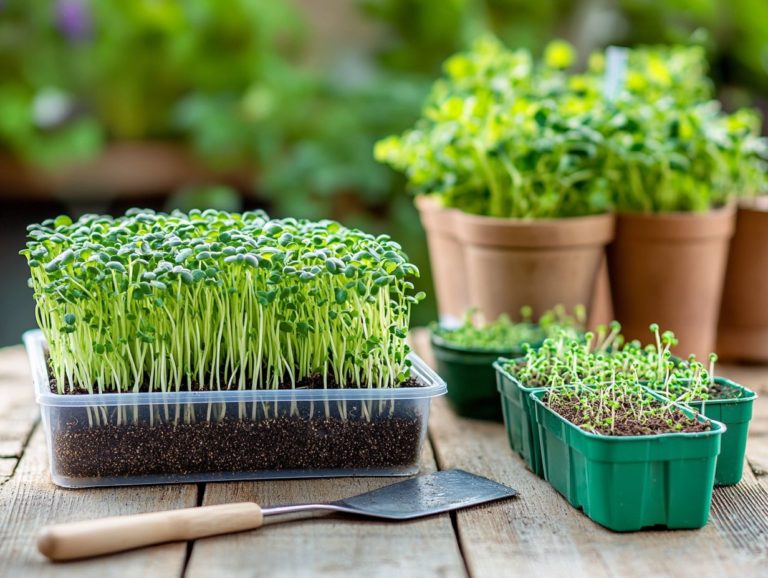Top 10 Microgreen Lighting Solutions
Growing microgreens is rewarding. However, it comes with challenges, especially in choosing the right lights for optimal growth.
With numerous lighting options available, selecting the right one can greatly impact the growth and nutrient profile of your microgreens. This article explores the top ten lighting solutions, from the benefits of natural sunlight to specialized full-spectrum lights, while examining critical factors for optimal growth.
Whether you’re starting out or are an experienced grower, you ll find valuable insights to elevate your microgreen garden.
Contents
- Key Takeaways:
- 1. Natural Sunlight
- 2. LED Grow Lights
- 3. Fluorescent Lights
- 4. High-Intensity Discharge (HID) Lights
- 5. Compact Fluorescent Lights (CFL)
- 6. T5 Fluorescent Lights
- 7. Metal Halide (MH) Lights
- 8. High-Pressure Sodium (HPS) Lights
- 9. Full-Spectrum Lights
- 10. Combination Lighting
- What Are Microgreens and Why Do They Need Special Lighting?
- What Are the Common Mistakes to Avoid When Using Microgreen Lighting?
- Frequently Asked Questions
- What are the top 10 microgreen lighting solutions?
- Which type of grow light is best for microgreens?
- Can I use regular household lights for growing microgreens?
- What is the ideal spectrum of light for microgreens?
- Do I need to supplement natural sunlight for growing microgreens?
- Can I use multiple types of grow lights for my microgreens?
Key Takeaways:
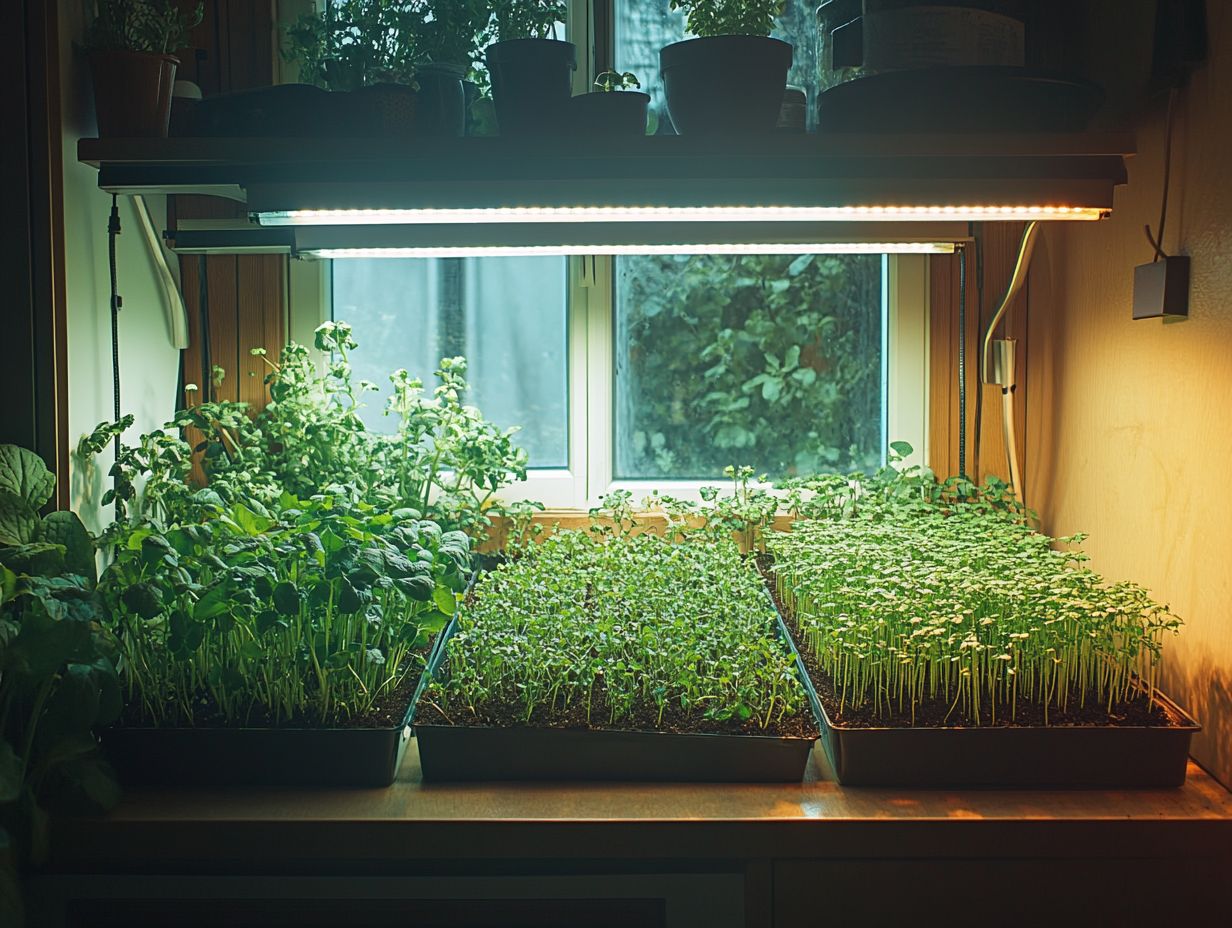
- LED grow lights, including Barrina and Active Grow options, are popular and efficient for growing microgreens, offering customizable spectrums and long lifespans.
- Natural sunlight is the most affordable and preferred option but requires care for optimal growth.
- Consider factors like spectrum, intensity, and cost when choosing the best lighting solution for microgreens.
1. Natural Sunlight
Natural sunlight is vital for the growth of your microgreens. It provides the necessary light for photosynthesis, enhancing their development and nutrient density. As a home grower, you want to optimize sunlight exposure in your greenhouse or high tunnel to ensure your microgreens thrive.
Understanding the specific light needs of various microgreens can improve their growth and flavor. For instance, blue light helps the plants grow strong and green, while red light supports flowering.
Use tools like light meters or smartphone apps to track sunlight patterns throughout the day. Adjust your planting schedules accordingly. Place reflective materials around your growing areas to maximize light intake and ensure your microgreens get enough exposure, even on cloudy days.
This strategy boosts plant vitality and enhances yield and nutritional benefits, giving you the best possible results.
2. LED Grow Lights
LED grow lights are gaining popularity among home growers and microgreens enthusiasts, and it s easy to see why. They provide excellent energy efficiency and deliver the precise light intensity and temperature needed for optimal microgreen growth.
These lights consume significantly less power than traditional bulbs and produce less heat. You can customize the light spectrum for different stages of plant development, resulting in healthier microgreens.
Brands like Active Grow excel in this area, offering full-spectrum lighting and adjustable settings tailored to home cultivators needs. By using these advanced grow lights, you can adopt a more sustainable approach to gardening while maximizing your yield.
3. Fluorescent Lights
Fluorescent lights are versatile and loved by many gardeners for growing microgreens. They provide the right levels of light without breaking the bank.
These lights come in various types, such as T5, T8, and T12 bulbs, each offering different brightness levels and energy efficiency. If you re cultivating microgreens indoors, the T5 option may be your best choice due to its superior lumen output and slim design, perfect for maximizing space.
When comparing fluorescent lights with other options like LEDs or incandescent bulbs, they often strike a balance between affordability and performance. For best results, position these lights about 6-12 inches above your plants for consistent light exposure without overheating.
4. High-Intensity Discharge (HID) Lights
High-Intensity Discharge (HID) lights, including metal vapor lights, are essential in commercial growing environments. They offer the high light intensity required for cultivating vibrant microgreens and other plants.
You ll appreciate these lights for their ability to provide a spectrum of light that fuels vigorous growth, making them perfect for both home setups and expansive commercial operations. However, this intensity comes with a cost HID lights consume a considerable amount of energy, which could lead to higher electricity bills.
In commercial greenhouses, this energy use can impact your overall profitability. As a home grower, you might struggle to balance performance and costs. The heat produced by these lights requires careful management to prevent overheating, especially in compact growing spaces.
5. Compact Fluorescent Lights (CFL)
Compact Fluorescent Lights (CFL) present an energy-efficient solution for microgreens growers. They strike an excellent balance between light output and energy consumption while easily fitting into smaller spaces.
These versatile lights excel at promoting healthy growth, making them perfect for urban gardeners or anyone working with limited cultivation room. Their compact size enables you to use them in various settings, from shelves to window sills, ensuring that even those living in apartments can successfully nurture vibrant microgreens.
CFLs stay cool and protect your precious plants! They emit significantly less heat compared to traditional bulbs, minimizing the risk of overheating your sensitive young plants. This enhances the growing environment and reduces cooling costs, making CFLs a savvy investment for anyone looking to elevate their indoor gardening experience.
6. T5 Fluorescent Lights
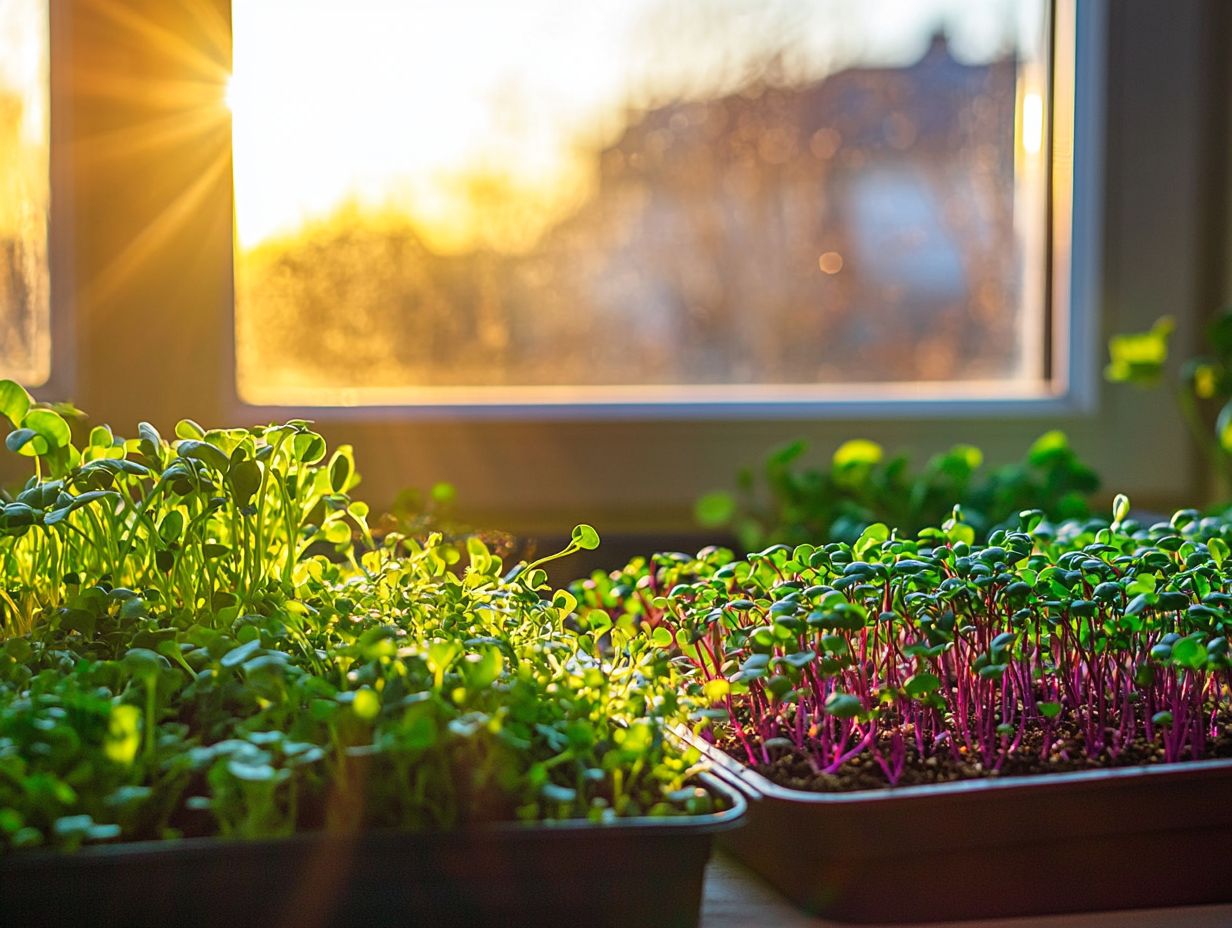
T5 fluorescent lights are highly prized in the gardening community for their exceptional light spectrum output. They are the perfect choice for cultivating microgreens indoors.
In addition to their impressive spectrum, these lights are remarkably energy-efficient. They help you keep electricity costs down while providing the illumination necessary for healthy growth. They emit a balanced mix of blue and red wavelengths crucial for photosynthesis, and their slim design makes installation a breeze in any growing space be it your home kitchen, basement, or greenhouse.
For the best results, position the lights just a few inches above your microgreens to ensure they receive adequate light without the risk of overheating. Regularly rotating the trays will also promote even light distribution, encouraging uniform growth and maximizing your microgreens’ potential.
Don t wait! Start your indoor garden today with T5 lights for spectacular results!
7. Metal Halide (MH) Lights
Metal Halide (MH) lights shine bright with their high intensity and broad spectrum. They make an excellent choice for cultivating microgreens and other rapidly growing plants.
These lights can significantly boost photosynthesis, leading to lush, vibrant growth and the cultivation of nutrient-dense varieties. However, it s important to be aware of their drawbacks, particularly the heat they generate. This may require additional cooling systems to maintain ideal growing conditions.
When you use MH lights in your home microgreen setup, positioning them at the right distance from your plants is essential. This prevents scorching while ensuring adequate light coverage. Adjusting the photoperiod the duration of light exposure each day and monitoring humidity levels will help you achieve a harmonious balance, allowing you to fully enjoy the benefits of this lighting technology.
8. High-Pressure Sodium (HPS) Lights
High-Pressure Sodium (HPS) lights are often paired with Metal Halide lights to create a unique light spectrum. This spectrum enhances the flowering phase of plant growth, but using HPS for microgreens requires careful consideration.
HPS lights deliver intense light that encourages flowering. However, this intensity and the heat they emit can stress delicate microgreens, leading to leggy or burnt seedlings.
In these cases, incorporating Metal Halide lights may help. These lights offer a cooler spectrum, which is ideal for vegetative growth.
By mixing both HPS and MH lights, you can create the perfect light conditions for your microgreens. This ensures they thrive and produce vibrant yields.
9. Full-Spectrum Lights
Full-spectrum lights mimic natural sunlight and are a top choice for cultivating microgreens. They provide a comprehensive range of wavelengths that ensures robust plant growth.
These lights support photosynthesis and enhance the overall vitality of your plants. Compared to traditional options like fluorescent or incandescent bulbs, full-spectrum LEDs shine with clear advantages.
LEDs generate less heat and are more energy-efficient, which can lower your electricity bills. Plus, these lights last longer, so you won’t have to replace them as often.
Embracing full-spectrum LEDs can dramatically boost the quality and growth rate of your microgreens. They are a reliable alternative to outdated lighting methods!
10. Combination Lighting
Combination lighting mixes different types of grow lights, like LED shop lights and fluorescent options. This approach customizes solutions for optimizing microgreens growth in various environments.
Utilizing the strengths of each light type allows you to create the ideal spectrum. For instance, pairing energy-efficient LED lights with fluorescent ones can ensure your microgreens receive the correct exposure.
This strategy benefits young microgreens, as some species thrive under higher intensity light, while others prefer softer illumination. A well-balanced combination mimics natural sunlight, enhancing photosynthesis and moisture retention.
What Are Microgreens and Why Do They Need Special Lighting?
Microgreens are young, edible plants packed with flavor and nutrients. To grow them well, you need specialized lighting that promotes robust growth since traditional lighting methods fall short.
These greens are typically harvested just after the first true leaves emerge. They contain a rich concentration of vitamins, minerals, and antioxidants.
For optimal growth, using specific light spectrums is crucial. These spectrums significantly influence the natural chemicals in plants that affect their flavor and health benefits.
For example, full-spectrum LED lights mimic natural sunlight. This ensures your vibrant plants receive the right wavelengths to enhance their nutrient density.
By balancing the lighting, you not only improve their flavor but also support healthy photosynthesis. This leads to a more robust harvest that can elevate your culinary creations!
What Are the Key Factors to Consider When Choosing Microgreen Lighting?
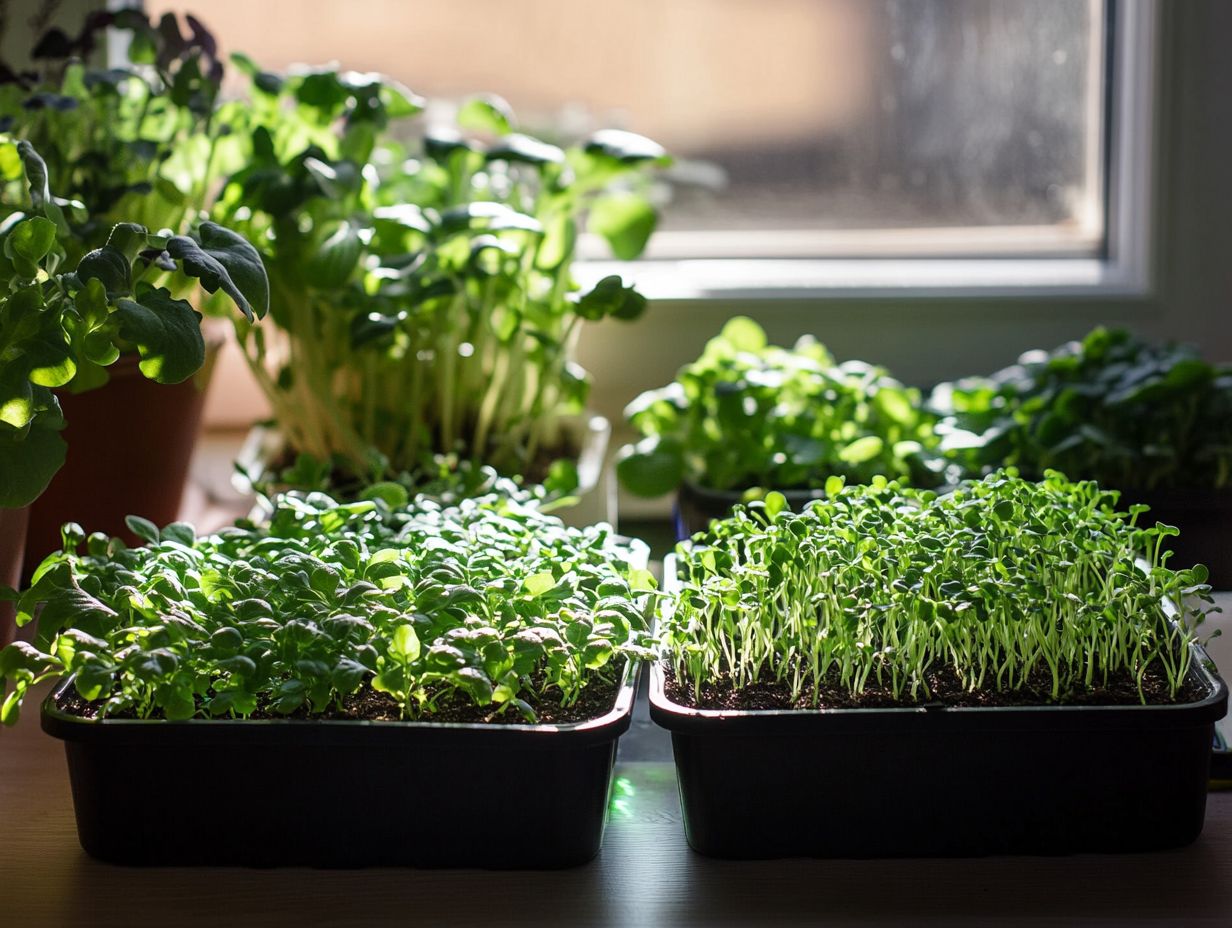
When you’re selecting the perfect lighting for microgreens, there are several key factors to consider: light intensity, light temperature, and specific grow light recommendations tailored to the unique needs of these delicate plants.
Understanding these elements is crucial as they directly impact growth rates, nutrient levels, and overall health. For instance, microgreens flourish under intense light, typically in the range of 200 to 400 mol/m /s, which fosters robust growth. Keeping the right light temperature around 6500K ensures your plants receive the appropriate spectrum for growth, favoring cooler shades that closely mimic natural daylight.
Depending on the specific microgreens you’re cultivating, like basil or broccoli, adjusting the duration of light exposure generally around 12 to 16 hours per day can lead to optimal results. By utilizing LED grow lights, you’ll see faster growth and benefit from energy efficiency. For the best outcomes, consider exploring the top 10 must-have microgreen supplies that can significantly enhance their growth potential.
How Can the Type of Lighting Affect the Growth and Nutrient Content of Microgreens?
The type of lighting you choose can dramatically impact both the growth rate and nutrient content of your microgreens, with different light categories influencing the process plants use to make food from light and overall health.
Consider the variations in lighting conditions LED, fluorescent, and natural sunlight all of which can lead to distinct growth patterns in your microgreens. For example, LED lights are celebrated for their efficiency and ability to emit specific light spectrums, enhancing certain nutrient profiles. This ultimately fosters stronger flavors and higher vitamin content. In contrast, fluorescent lighting may not be as specialized, but it still supports consistent growth. To further optimize your microgreen setup, check out the top 5 microgreen support systems.
Understanding the specific light spectrum needs of each microgreen variety is crucial for you. By tailoring your lighting setups accordingly, you can optimize growth and ensure your delicate plants achieve their full potential, resulting in vibrant and nutrient-rich yields. Additionally, consider using the top 10 microgreen sprayers for even watering to enhance your growing process.
What Are the Pros and Cons of Each Lighting Solution?
Every lighting solution available for microgreens comes with its own unique set of pros and cons, shaping your decisions as a home grower based on your specific needs and growing environment.
The type of light you choose significantly impacts growth rates, yield, and even the flavor profiles of various microgreen varieties. For instance, understanding light needs for microgreens can help you realize that LED lights are appealing due to their energy efficiency and long lifespan. This makes them perfect for nurturing delicate microgreens like basil or arugula, which flourish under specific wavelengths.
While fluorescent lights may not be as energy-efficient, they offer a broader spectrum that can benefit faster-growing varieties, such as radish microgreens. Conversely, HID lights pack a punch with their high intensity, making them suitable for larger setups, but they can generate heat, which might stress more sensitive crops if not carefully managed. For those interested in growing microgreens, consider exploring the top 5 greenhouses for microgreen growing to enhance your setup.
Ultimately, grasping the unique needs of each microgreen can enable you to select the most fitting lighting solution for your growing endeavors.
What Are Some Tips for Setting Up and Using Microgreen Lighting?
Setting up effective lighting for your microgreens involves several key tips that ensure you position the right light fixture correctly to optimize plant health and growth.
Typically, experienced home growers recommend using LED or fluorescent lights, as these provide the necessary spectrum for photosynthesis without generating excess heat. You should place the light approximately 12 to 24 inches above the seedlings, allowing ample room for growth while maintaining sufficient light intensity.
Timing is crucial; aim for a cycle of 14 to 16 hours of light daily to mimic natural sunlight and promote vigorous growth. Regular maintenance, such as cleaning dust from the fixtures and monitoring the light spectrum, is essential to keeping your microgreens thriving in their indoor environment.
Try these tips today for healthier microgreens!
What Are the Common Mistakes to Avoid When Using Microgreen Lighting?
Home growers often stumble upon common pitfalls when it comes to microgreen lighting, such as improper light intensity, positioning, and timing. These mistakes can significantly impact the health of your plants.
Watch for signs like stunted growth, pale leaves, or elongated stems clear indicators that your microgreens aren t basking in optimal conditions.
To turn things around, it’s essential to use full-spectrum LED lights that provide the right balance of wavelengths, ensuring your plants receive the energy needed for photosynthesis. Position the lights about 2 to 3 inches above the plants to prevent overcrowding and encourage even growth.
Maintain a consistent lighting schedule of 12 to 16 hours daily to mimic natural daylight, nurturing robust, vibrant microgreens that thrive and yield impressively. Always monitor your light temperature to keep conditions optimal.
Check out the video for tips on optimizing your microgreen lighting.
Frequently Asked Questions
What are the top 10 microgreen lighting solutions?
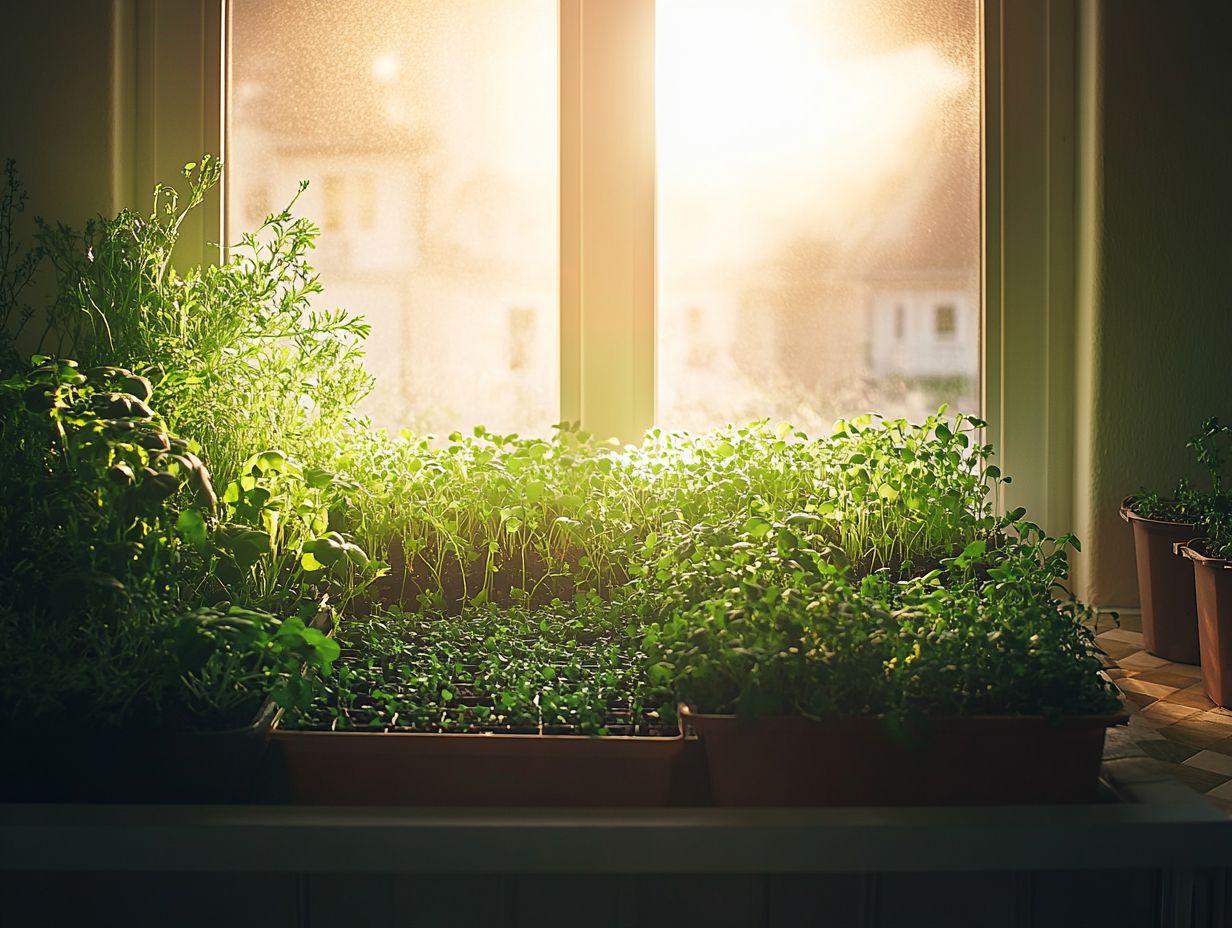
The top 10 microgreen lighting solutions include LED grow lights, fluorescent grow lights, compact fluorescent lights, high-pressure sodium lights, metal halide lights, halogen lights, incandescent lights, natural sunlight, greenhouse lighting systems, and DIY lighting setups. Many growers prefer Barrina or Active Grow when selecting lighting options.
Which type of grow light is best for microgreens?
LED grow lights are typically considered the best option for growing microgreens due to their energy efficiency, full spectrum lighting, and minimal heat output. They are highly recommended for growing microgreens.
Can I use regular household lights for growing microgreens?
While regular household lights may provide some illumination for your microgreens, they are not designed specifically for plant growth and may lack the necessary light spectrum for optimal growth. Consider the different types of light available.
What is the ideal spectrum of light for microgreens?
The ideal spectrum of light for microgreens includes a balance of blue and red light, as these wavelengths are most absorbed by plants for photosynthesis and growth. Adjust according to microgreen recommendations.
Do I need to supplement natural sunlight for growing microgreens?
Depending on your location and the time of year, natural sunlight may not provide enough light for optimal microgreen growth. Supplementing with grow lights, especially LED lights, ensures consistent and sufficient lighting for your plants.
Can I use multiple types of grow lights for my microgreens?
Yes, you can also combine different types of grow lights to provide full spectrum lighting for your microgreens. These can be found at local home improvement stores or hydroponic stores. This approach promotes healthy and balanced growth.
With the right lighting, your microgreens can flourish get started today!


